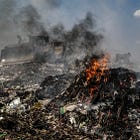If the state won’t fix it, well ... you know the drill
Drought has highlighted the failure of the state to build dams and improve the country’s water security, and Zimbabweans are having to dig deep to compensate.
Jeffrey Moyo in Harare

Behind a tall wall outside a private residence in the Harare suburb of Belvedere, people queue to collect water from a borehole installed by a generous resident. Cars parked by the roadside suggest that many reside far away. Communal taps are now commonplace in the capital city. A godsend to the city’s urban poor, they also indicate how much the current drought is scorching the country.
El Niño is a naturally occurring weather event which heats parts of the Pacific Ocean, driving drought in the southern hemisphere and floods in the north. A hotter world means more energy powering a more devastating El Niño.
In April, the government announced the country was in a nationwide state of disaster. Zimbabwe’s cities and towns are home to millions of, many of them poor and reliant on naturally occurring bodies of water. The drought has left them high and dry.
In response to the scarcity, the City of Harare is rationing water. The municipality gets water from dams and lakes that are increasingly drying up.
Many residents now buy water from vendors who go around with tanks mounted on trucks. Laura Chiwanza, a mother of four, tells The Continent that a 5,000-litre tank costs $45. “When I use that sparingly with my family, it lasts for nearly two and half weeks.”
Others form winding queues at the communal water points set up by Good Samaritans. In low income neighbourhoods like Epworth, just outside Harare, residents who still rely on wells often stand for hours waiting for enough water to pool; waiting their turn to draw what little they can.
Many people are rationing water tightly, even for the most essential needs like drinking and bathing. Another resident in Harare’s Kambuzuma area says he has switched to bathing only twice a week.
Further south, in Bulawayo, Lindiwe Msipa says: “I used to drink at least two litres of water, but because there is little of it, I have cut down to just two glasses in order to save.”
A few have found some sort of silver-lining in the crisis. Driving a donkey-drawn scotch-cart laden with water for sale, Latwell Sambiri in Harare’s Dzivarasekwa neighbourhood says he has made a few hundred dollars because of the crisis. Charity organisations are trying to mitigate the worst of drought by sinking boreholes, fast. In Bulawayo’s low income areas, workers supported by DanChurchAid, a humanitarian non-governmental organisation, can be seen drilling boreholes.
These groups say they hope their efforts will curb diarrhoeal diseases like cholera, which infected 34,550 people and killed 700 others between February 2023 and August 2024.
The government’s own long-term solution – a system of 12 water reservoirs being built by the Zimbabwe National Water Service – seems far from done. By its own estimate, only two will be complete by the end of next year: the $109-million Kunzvi dam in Harare’s northeast, and the $600-million Gwayi-Shangani in Bulawayo.
Kunzvi has been under construction for over a decade and Gwayi-Shangani construction started even further back, in 2004. In 2021, Paul Denge, a water service engineer, cited “inconsistent funding” for the delay in the completion of Gwayi-Shangani dam.
With this year on track to break the 1.5°C heating mark – seen by scientists as a catastrophic number for Africans – the kinds of droughts seen in Zimbabwe in recent years will be all the more likely.






